

Taking a Stand Against Those Who Pollute Drinking Water. Keeping water clean and safe enough to drink is a tough job, especially when there are forces that sabotage this vital public health goal.

In an unprecedented move to fight back against those responsible for jeopardizing its drinking water, the Des Moines Water Works filed a federal lawsuit last year against three upstream counties that have long allowed farm pollution to flow downriver into the city of Des Moines. The utility is desperate to get help in cleaning up the two heavily polluted rivers that provide drinking water for the 500,000 people in Iowa’s capital – the state’s most populous city.
Watch this video explaining the issue of nitrate pollution in Iowa and what one farmer and the CEO of the Des Moines Water Works say about the issue: The suit, which will be heard next year, came about largely because the Des Moines Water Works had reached a breaking point. Verdict Secured for Oil and Gas Water Pollution. Suffolk Closeup: A water pollution solution. In an effort to reduce the amount of nitrogen getting into bays and other water bodies and to protect groundwater, Suffolk County Legislator Bill Lindsay (D-Holbrook) has introduced a measure aimed at reducing the application of fertilizer.
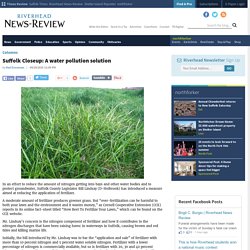
A moderate amount of fertilizer produces greener grass. But “over-fertilization can be harmful to both your lawn and the environment and it wastes money,” as Cornell Cooperative Extension (CCE) reports in its online fact-sheet titled “How Best To Fertilize Your Lawn,” which can be found on the CCE website. Mr. Lindsay’s concern is the nitrogen component of fertilizer and how it contributes to the nitrogen discharges that have been raising havoc in waterways in Suffolk, causing brown and red tides and killing marine life. Initially, the bill introduced by Mr. The county is now considering, Mr. However, changes in the bill are still being worked on and are “not finalized.”
Mr. A resident of Oakdale, Mr. Comments comments. High air and water pollution in India’s 41 tier-II cities. Central Pollution Control Board finds that the waste treatment capacity of the cities barely covers 10% of their sewage New Delhi: If you thought moving out of metro cities such as New Delhi and Mumbai can save you from pollution, think again.
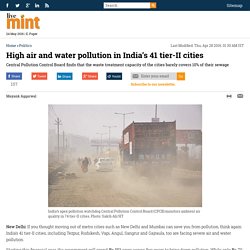
India’s 41 tier-II cities, including Tezpur, Rishikesh, Vapi, Angul, Sangrur and Gajraula, too are facing severe air and water pollution. Starting this financial year, the government will spend Rs.553 crore across five years to bring down pollution. While only Rs.70 crore is allocated for the abatement of pollution in 2016-17, it is anticipated to more than double to Rs.150 crore in 2020-21. The country’s apex pollution watchdog, the Central Pollution Control Board (CPCB), monitors ambient air quality in 74 tier-II cities. “Analysis of data shows that 41 cities exceed the ambient air quality standard. According to the minister, municipal corporations are largely unable to handle the entire sewage generated with the existing infrastructure.
New report raises concerns over possible connection between fracking and water pollution. <div>Please enable Javascript to watch this video</div> OKLAHOMA CITY - There have long been concerns in our state that wastewater injection by oil companies is the cause of all the earthquakes we’ve been experiencing in recent years.

Now, another concern is coming to the forefront – whether it could be contaminating our water. One Oklahoma geologist said a recent Washington Post article raises serious questions. “This mystery was solved: Scientists say chemicals from fracking wastewater can taint fresh water nearby,” the article declares. Bob Jackman, an Oklahoma geologist, said he fears many wells will be abandoned due to the financial troubles of the oil and gas industry right now. And, he said abandoned wells that are not properly maintained can leak. “It is a massive problem and, as we go through this cycle of bankruptcies, it’s going to be a long-term problem,” Jackman said.
Jackman said we need testing like that in our state. “How is the state of Oklahoma addressing this problem? China's new weapon against water pollution: its people. By Rob Schmitz May 02, 2016 | 5:00 AM China's government calls its newest environmental campaign "hei chou he," which literally translates to "black and stinky rivers.
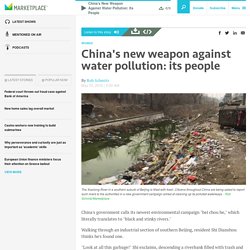
" Walking through an industrial section of southern Beijing, resident Shi Dianshou thinks he's found one. "Look at all this garbage! " Clean Water Laws Are Neglected, at a Cost in Suffering. In parts of New York, Rhode Island, Ohio, California and other states where sewer systems cannot accommodate heavy rains, untreated human waste has flowed into rivers and washed onto beaches.
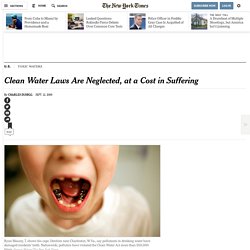
Drinking water in parts of New Jersey, New York, Arizona and Massachusetts shows some of the highest concentrations of tetrachloroethylene, a dry cleaning solvent that has been linked to kidney damage and cancer. (Specific types of water pollution across the United States will be examined in future Times articles.) Photo The Times’s research also shows that last year, 40 percent of the nation’s community water systems violated the Safe Drinking Water Act at least once, according to an analysis of E.P.A. data. Those violations ranged from failing to maintain proper paperwork to allowing carcinogens into tap water. In some cases, people got sick right away. What is Water Pollution for children. State seeks control over US water pollution monitoring. The battle over industrial water pollution in Alabama.
By Gigi Douban April 26, 2016 | 11:49 AM Safe drinking water is an issue that’s been playing out not just in Flint, Michigan, but in cities from Parksburg, West Virginia, to Hoosick Falls, New York.
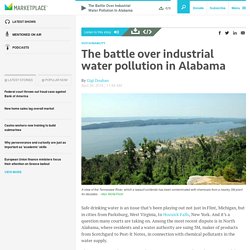
And it’s a question many courts are taking on. Water Pollution Facts, Effects of Water Contamination, Clean Water Act. Water pollution. Sir: Reports suggest that around 62 percent of Pakistan’s urban and 84 percent of its rural population do not treat their water, resulting in 100 million cases of diarrheal diseases registered in hospitals with 40 percent of deaths attributed to drinking polluted water.

An estimated 250,000 child deaths occur each year in Pakistan due to water borne diseases. The specific contaminants leading to water pollution include a spectrum of chemicals. Study Seeks To Identify Water Pollution Sources In Vermont. National Geographic Freshwater 101: Pollution. As technology improves, scientists are able to detect more pollutants, and at smaller concentrations, in Earth’s freshwater bodies.

Containing traces of contaminants ranging from birth control pills and sunscreen to pesticides and petroleum, our planet's lakes, rivers, streams, and groundwater are often a chemical cocktail. Beyond synthetic pollution, freshwater is also the end point for biological waste, in the form of human sewage, animal excrement, and rainwater runoff flavored by nutrient-rich fertilizers from yards and farms. These nutrients find their way through river systems into seas, sometimes creating coastal ocean zones void of oxygen—and therefore aquatic life—and making the connection between land and sea painfully obvious.
When you dump paint down the drain, it often ends up in the ocean, via freshwater systems. New Study Shows Plastic in Oceans Is on the Rise. Scientists have come up with a new way to measure ocean trash—and the numbers are even worse than thought.

In 2010, eight million tons of plastic trash ended up in the ocean from coastal countries—far more than the total that has been measured floating on the surface in the ocean's "garbage patches. " That's the bad news. The even worse news is that the tonnage is on target to increase tenfold in the next decade unless the world finds a way to improve how garbage is collected and managed. The findings are part of a groundbreaking study published Thursday in Science that for the first time quantifies how much garbage flows into the world's oceans every year. Until now, most efforts to measure ocean debris have involved sample counts of plastic floating on the surface in large garbage patches in each of the world's oceans.
The new study also identifies the major sources of plastic debris and names the top 20 countries generating the greatest amount of ocean-bound trash.